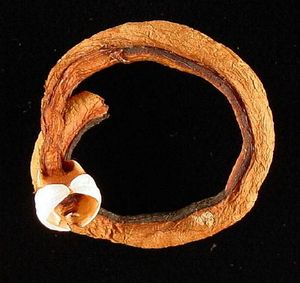Teredinibacter turnerae: Difference between revisions
Ahronflowers (talk | contribs) |
Ahronflowers (talk | contribs) |
||
| Line 5: | Line 5: | ||
==Characteristics of the host== | ==Characteristics of the host== | ||
Commonly known as "shipworms" because they digest the wood immersed in salt water, ''Lyrodus pedicellatus'' are small salt water clams with small shells. Even thought they look like worms, they are not actually worms. There are 300 species of ''Terediniae'', the shipworm family, which all have a Deshayes. Deshayes is a special organ where the digestion of cellulose (wood) occurs. | Commonly known as "shipworms" because they digest the wood immersed in salt water, ''Lyrodus pedicellatus'' are small salt water clams with small shells. Even thought they look like worms, they are not actually worms. There are 300 species of ''Terediniae'', the shipworm family, which all have a Deshayes. Deshayes is a special organ where the digestion of cellulose (wood) occurs. | ||
[[File:Shipworm.jpg|thumb|"Lyrodus pedicellatus (shipworm)" [http://en.wikipedia.org/wiki/File:Shipworm.jpg]]] | [[File:Shipworm.jpg|thumb|"''Lyrodus pedicellatus'' (shipworm)" [http://en.wikipedia.org/wiki/File:Shipworm.jpg]]] | ||
==Host-Symbiont Interaction == | ==Host-Symbiont Interaction == | ||
Revision as of 17:33, 18 November 2011
Characteristics of the symbiont/pathogen
Located in the proteobacterium family, Teredinibacter turnerae are gram-negative rods that have polar flagellum for mobility. The genome of T. tunerae has almost been completely sequenced, having 1453 base pairs.
Characteristics of the host
Commonly known as "shipworms" because they digest the wood immersed in salt water, Lyrodus pedicellatus are small salt water clams with small shells. Even thought they look like worms, they are not actually worms. There are 300 species of Terediniae, the shipworm family, which all have a Deshayes. Deshayes is a special organ where the digestion of cellulose (wood) occurs.

Host-Symbiont Interaction
What kind of interaction do host and symbiont have? How is the host affected by the relationship? How does the host acquire and transmit the symbiont? Is the interaction obligate or facultative?
Molecular Insights into the Symbiosis
Describe molecular/genetic studies on the symbiosis.
Ecological and Evolutionary Aspects
What is the evolutionary history of the interaction? Do particular environmental factors play a role in regulating the symbiosis?
Recent Discoveries
Describe two findings on the symbiosis published within the last two years.
References
[Sample reference] [[2] Seemanapalli SV, Xu Q, McShan K, Liang FT. 2010. Outer surface protein C is a dissemination-facilitating factor of Borrelia burgdorferi during mammalian infection. PLoS One 5:e15830.]
Edited by [insert your names here!], students of Grace Lim-Fong
This template is just a general guideline of how to design your site. You are not restricted to this format, so feel free to make changes to the headings and subheadings and to add or remove sections as appropriate.
